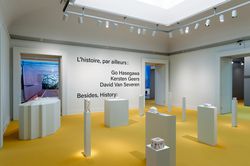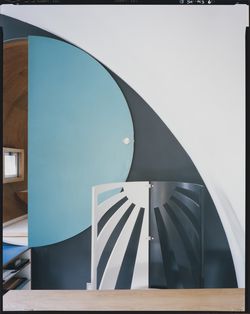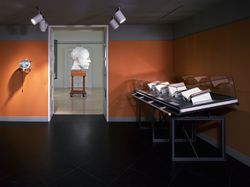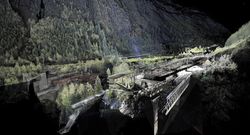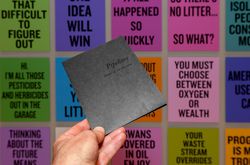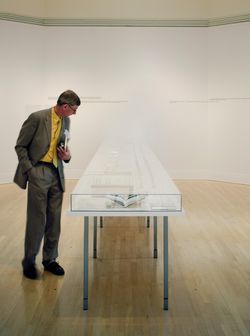What role can history play in contemporary architecture practice? Rather than adopting a postmodern attitude or evoking past discussions and historical architectural forms, Go Hasegawa, Kersten Geers, and David Van Severen address contemporary issues in their work while remaining in dialogue with history. Even with distinct pasts and contexts, affinities emerge in shared(...)
Main galleries Keyword(s):
Besides, History, Go Hasegawa, Kersten Geers, David Van Severen, Office, KGDVS, Bas Princen
10 May 2017 to 15 October 2017
Besides, History: Go Hasegawa, Kersten Geers, David Van Severen
Actions:
Description:
What role can history play in contemporary architecture practice? Rather than adopting a postmodern attitude or evoking past discussions and historical architectural forms, Go Hasegawa, Kersten Geers, and David Van Severen address contemporary issues in their work while remaining in dialogue with history. Even with distinct pasts and contexts, affinities emerge in shared(...)
Main galleries Keyword(s):
Besides, History, Go Hasegawa, Kersten Geers, David Van Severen, Office, KGDVS, Bas Princen
Kazuo Shinohara was a deeply influential figure in postwar architecture in Japan best known for his individual houses, but he remains little studied today, especially outside Japan. Shinohara connected traditional forms and an investigation of modernist tenets with the high-tech and information technology moments yet to come. What was his attitude toward history, and how(...)
Paul Desmarais Theatre Keyword(s):
David B. Stewart, Kazuo Shinohara, What is/was history for…
21 September 2017, 6:30pm
David B. Stewart, what was history for Kazuo Shinohara?
Actions:
Description:
Kazuo Shinohara was a deeply influential figure in postwar architecture in Japan best known for his individual houses, but he remains little studied today, especially outside Japan. Shinohara connected traditional forms and an investigation of modernist tenets with the high-tech and information technology moments yet to come. What was his attitude toward history, and how(...)
Paul Desmarais Theatre Keyword(s):
David B. Stewart, Kazuo Shinohara, What is/was history for…
events
Learning from… China
In Urbanising Southern China: Poverty, Minorities, and Development, Gregory Guldin examines the social and environmental consequences of accelerated industrialisation in China, as agricultural villages become dense urban agglomerations at unprecedented rates. A specialist in Chinese urbanisation, ethnicity, and politics, Gregory Guldin is Professor of Anthropology at the(...)
3 May 2007
Learning from… China
Actions:
Description:
In Urbanising Southern China: Poverty, Minorities, and Development, Gregory Guldin examines the social and environmental consequences of accelerated industrialisation in China, as agricultural villages become dense urban agglomerations at unprecedented rates. A specialist in Chinese urbanisation, ethnicity, and politics, Gregory Guldin is Professor of Anthropology at the(...)
events
3 May 2007
Meditations on Piero presents contemporary sculptures by British/Canadian artist Geoffrey Smedley alongside over thirty rare books from the fifteenth to the eighteenth centuries. The sculptures draw their inspiration from a series of drawings of the human head by the great Italian Renaissance artist Piero della Francesca. The exhibition relates these drawings and(...)
Octagonal gallery
2 May 2001 to 16 September 2001
Meditations on Piero
Actions:
Description:
Meditations on Piero presents contemporary sculptures by British/Canadian artist Geoffrey Smedley alongside over thirty rare books from the fifteenth to the eighteenth centuries. The sculptures draw their inspiration from a series of drawings of the human head by the great Italian Renaissance artist Piero della Francesca. The exhibition relates these drawings and(...)
Octagonal gallery
In this lecture, Christophe Girot discusses digital landscape models: A quiet revolution has taken place in digital landscape design and analysis over the past decade, caused by the introduction of digital point-cloud models. The scope and precision of these digital landscape models, created with terrestrial laser scanners and mobile and airborne lidar, lead to new(...)
Paul Desmarais Theatre
6 October 2016, 6pm
Unravelling the Digital Landscape
Actions:
Description:
In this lecture, Christophe Girot discusses digital landscape models: A quiet revolution has taken place in digital landscape design and analysis over the past decade, caused by the introduction of digital point-cloud models. The scope and precision of these digital landscape models, created with terrestrial laser scanners and mobile and airborne lidar, lead to new(...)
Paul Desmarais Theatre
archives
Level of archival description:
Fonds
PGL architectes fonds
AP014
Synopsis:
Le fonds PGL architectes, 1959 – 1994, témoigne des activités de la firme d’architecture montréalaise, Papineau Gérin-Lajoie Le Blanc architectes, autant que ses sociétés affiliées et firmes remplaçantes. La majorité du fonds comprend des documents qui représentent 70 projets architecturaux, incluant des projets entrepris à travers le Québec, à Ottawa, à de multiples endroits au Nunavut, ainsi que des projets internationaux. Le fonds met en évidence la participation du PGL dans la construction d'infrastructure coloniale au Nunavik et au Nunavut, y compris les travaux sur des écoles associées avec des foyers fédéraux, qui sont reconnus comme faisant partie du système des pensionnats autochtones du Canada. De plus, le fonds documente l’utilisation des panneaux de fibre de verre modulaires employés par PGL. Pour la plupart, les documents dans ce fonds se composent des dessins, des documents photographiques, et des documents textuels. _____________________________________________________________________________________________________________ The PGL architectes fonds, 1959 - 1994, documents the work and activities of the Montréal-based architecture firm, Papineau Gérin-Lajoie Le Blanc architectes, and its successor and affiliate companies. The records within this fonds represent 70 architectural projects undertaken by the firm, which include projects throughout Québec, Ottawa, and various locations in Nunavut, as well as some international projects. The fonds offers evidence of PGL’s participation in the construction of colonial infrastructure in Nunavik and Nunavut, including work on schools that are connected to Federal Hostels which are recognised as part of Canada's Indian Residential School system. The fonds also contains records documenting PGL’s use of modular, fiberglass-reinforced plastic panels in construction. The records within this fonds largely consist of drawings, photographic materials, and textual records.
1959 - 1994
PGL architectes fonds
Actions:
AP014
Synopsis:
Le fonds PGL architectes, 1959 – 1994, témoigne des activités de la firme d’architecture montréalaise, Papineau Gérin-Lajoie Le Blanc architectes, autant que ses sociétés affiliées et firmes remplaçantes. La majorité du fonds comprend des documents qui représentent 70 projets architecturaux, incluant des projets entrepris à travers le Québec, à Ottawa, à de multiples endroits au Nunavut, ainsi que des projets internationaux. Le fonds met en évidence la participation du PGL dans la construction d'infrastructure coloniale au Nunavik et au Nunavut, y compris les travaux sur des écoles associées avec des foyers fédéraux, qui sont reconnus comme faisant partie du système des pensionnats autochtones du Canada. De plus, le fonds documente l’utilisation des panneaux de fibre de verre modulaires employés par PGL. Pour la plupart, les documents dans ce fonds se composent des dessins, des documents photographiques, et des documents textuels. _____________________________________________________________________________________________________________ The PGL architectes fonds, 1959 - 1994, documents the work and activities of the Montréal-based architecture firm, Papineau Gérin-Lajoie Le Blanc architectes, and its successor and affiliate companies. The records within this fonds represent 70 architectural projects undertaken by the firm, which include projects throughout Québec, Ottawa, and various locations in Nunavut, as well as some international projects. The fonds offers evidence of PGL’s participation in the construction of colonial infrastructure in Nunavik and Nunavut, including work on schools that are connected to Federal Hostels which are recognised as part of Canada's Indian Residential School system. The fonds also contains records documenting PGL’s use of modular, fiberglass-reinforced plastic panels in construction. The records within this fonds largely consist of drawings, photographic materials, and textual records.
archives
Level of archival description:
Fonds
1959 - 1994
Second Nature
As part of the exhibition It’s All Happening So Fast, an interactive workshop is offered to cegep and university groups in order to explore the complex and contradictory relationships that Canada maintains with the environment. By taking a stand and speaking on behalf of entities motivated by a multiplicity of interests—ecosystems, architecture, ethics, economic systems,(...)
26 January 2017 to 7 April 2017
Second Nature
Actions:
Description:
As part of the exhibition It’s All Happening So Fast, an interactive workshop is offered to cegep and university groups in order to explore the complex and contradictory relationships that Canada maintains with the environment. By taking a stand and speaking on behalf of entities motivated by a multiplicity of interests—ecosystems, architecture, ethics, economic systems,(...)
archives
Level of archival description:
Fonds
AP171
Synopsis:
This fonds documents the professional practice and activities of the Foreign Office Architects between 1989 and 2011, with a primary focus on their architectural projects. The documents in the fonds include drawings and plans, photographic materials, presentation panels, models, textual records, and digital files relating to 192 projects and international exhibitions . Additionally, the fonds includes material relating to publications, office activities, and research.
circa 1983-2011
Foreign Office Architects fonds
Actions:
AP171
Synopsis:
This fonds documents the professional practice and activities of the Foreign Office Architects between 1989 and 2011, with a primary focus on their architectural projects. The documents in the fonds include drawings and plans, photographic materials, presentation panels, models, textual records, and digital files relating to 192 projects and international exhibitions . Additionally, the fonds includes material relating to publications, office activities, and research.
archives
Level of archival description:
Fonds
circa 1983-2011
Learning from... Montréal
Lance Blomgren uses his 2009 book Walkups—a novella set entirely within Montréal’s row house apartment buildings—as a springboard for an analysis of the discursive plane of fictional architecture. Looking at works by John Hejduk, Ilya Kabakov, Alice Aycock and others, Blomgren argues that contemporary modes of speculative architecture offer a vital, if ethically fraught,(...)
Paul-Desmarais Theatre
2 May 2013 , 7pm
Learning from... Montréal
Actions:
Description:
Lance Blomgren uses his 2009 book Walkups—a novella set entirely within Montréal’s row house apartment buildings—as a springboard for an analysis of the discursive plane of fictional architecture. Looking at works by John Hejduk, Ilya Kabakov, Alice Aycock and others, Blomgren argues that contemporary modes of speculative architecture offer a vital, if ethically fraught,(...)
Paul-Desmarais Theatre
Learning from… Ruscha and Venturi Scott Brown, 1962–1977 examines the relationship between the seminal illustrated books by artist Edward Ruscha and architects Robert Venturi and Denise Scott Brown that deal with the architecture and urbanism of the everyday in Los Angeles and Las Vegas during the 1960s and 1970s. Ruscha’s Every Building on the Sunset Strip and Venturi(...)
Octagonal gallery
31 March 2004 to 30 May 2004
Learning from… Ruscha and Venturi Scott Brown, 1962–1977
Actions:
Description:
Learning from… Ruscha and Venturi Scott Brown, 1962–1977 examines the relationship between the seminal illustrated books by artist Edward Ruscha and architects Robert Venturi and Denise Scott Brown that deal with the architecture and urbanism of the everyday in Los Angeles and Las Vegas during the 1960s and 1970s. Ruscha’s Every Building on the Sunset Strip and Venturi(...)
Octagonal gallery
